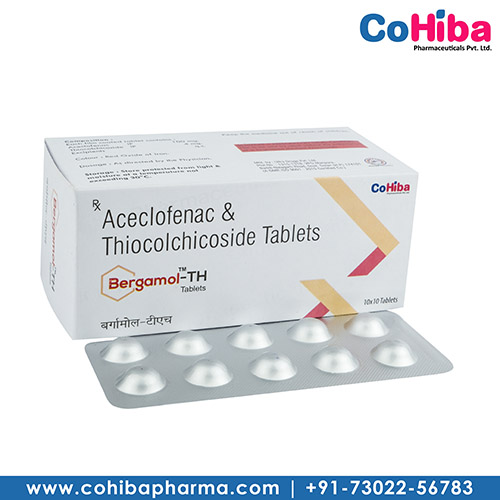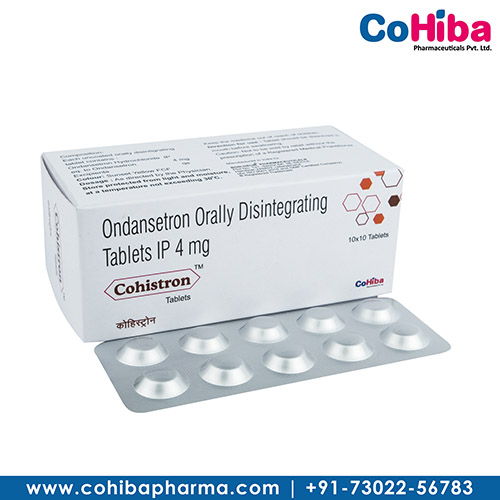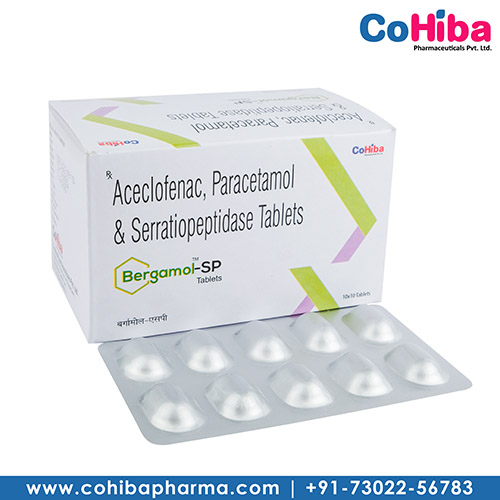Description
Aceclofenac 100mg & Thiocolchicoside 4mg Tablets: A combination drug called aceclofenac 100 mg and thiocolchicoside 4 mg tablets are used to treat inflammation and discomfort in the musculoskeletal system.
Aceclofenac (100mg): This nonsteroidal anti-inflammatory medicine (NSAID) reduces inflammation and pain in the body by preventing the synthesis of prostaglandins, which are responsible for these effects. For ailments including osteoarthritis, rheumatoid arthritis, ankylosing spondylitis, and musculoskeletal diseases, aceclofenac is frequently recommended.
Thiocolchicoside (4 mg) is a muscle relaxant made from the plant alkaloid colchicine. Thiocolchicoside relieves muscular spasms by relaxing skeletal muscles by acting directly on the central nervous system. Acute muscular pain, stiffness, and spasms brought on by musculoskeletal diseases are its main targets for therapy.
A single pill containing Aceclofenac and Thiocolchicoside is frequently given to treat the many manifestations of pain, inflammation, and muscle spasms that may coexist in some diseases. It combines the advantages of a muscle relaxant with an anti-inflammatory medicine.
How to Use Aceclofenac 100mg & Thiocolchicoside 4mg Tablets
Depending on your unique situation and the advice given by your healthcare provider, the directions for taking tablets containing the active ingredients Aceclofenac 100mg and Thiocolchicoside 4mg may change. It’s crucial to adhere to their recommendations and the details listed on the drug container. Here are some broad principles, though:
- Dosage: Follow your doctor’s instructions for taking the pills exactly. One pill taken orally with water is generally the standard dose for adults. Your doctor will decide on the frequency and length of usage, and it’s crucial to follow the dose instructions.
- Timing: To reduce the chance of stomach upset, the pills are normally taken with or right after a meal. Observe the suggested time guidelines on the box or those supplied by your doctor.
- Take the tablets whole, without chewing, crushing, or breaking them, unless your healthcare provider instructs you differently.
- Compliance: It’s critical to take the prescription regularly and exactly as directed. Take the missed dosage as soon as you recall it if you miss it. If your next dosage is approaching, skip the missed one and go on with your usual dosing regimen. Never take two doses at once to make up for a missing one.
- To prevent potential drug interactions, take precautions and tell your doctor about any other drugs or dietary supplements you are taking. Any underlying medical concerns you may have, such as liver or kidney issues, should also be disclosed to your healthcare professional since they may alter the way this medicine is used.
- Be mindful of any possible adverse effects that may be brought on by using these drugs. gastrointestinal issues, grogginess, sleepiness, and allergic responses are examples of typical side effects. Contact your doctor right away if you develop any negative side effects that are severe or persistent.
How does the drug work
Different modes of action govern how Aceclofenac and Thiocolchicoside function:
Aceclofenac:
- The group of medications known as nonsteroidal anti-inflammatory medicines (NSAIDs) includes aceclofenac. Cyclooxygenase (COX) enzyme activity is inhibited, more especially COX-1 and COX-2.
- Prostaglandins, which are chemicals implicated in pain, inflammation, and fever, are produced by COX enzymes. Aceclofenac lowers the formation of prostaglandins by inhibiting COX enzymes, which lessens the pain, inflammation, and fever related to numerous illnesses.
- Aceclofenac mostly inhibits the COX-2 enzyme, which is more engaged in the inflammatory response, while leaving the COX-1 enzyme unaffected.
- This enzyme is important for maintaining the stomach’s and kidneys’ protective functions.
Thiocolchicoside:
- A muscle relaxant that affects the central nervous system is thiocolchicoside.
- Although its precise mode of action is not well known, it is thought to work in a variety of ways.
- Gamma-aminobutyric acid (GABA) receptors are altered by thiocolchicoside in the spinal cord, which enhances the inhibitory action on motor neurons. This causes muscle relaxation and a decrease in stiffness and spasms.
- Thiocolchicoside may also have anti-inflammatory effects and affect the release of certain neurotransmitters that are involved in pain perception and muscular function.
Benefits of Using Aceclofenac 100mg & Thiocolchicoside 4mg Tablets
Due to the distinct activities of each component, the combination of tablets containing Aceclofenac 100 mg and Thiocolchicoside 4 mg provides several advantages. The following are some possible advantages of using this medication:
- Aceclofenac, a nonsteroidal anti-inflammatory medicine (NSAID), inhibits the synthesis of prostaglandins, which are chemicals involved in pain signaling and help relieve pain. It can ease a variety of pains, including those brought on by musculoskeletal problems, osteoarthritis, arthritis, and other inflammatory ailments.
- The anti-inflammatory effects of aceclofenac serve to lessen inflammation, which is frequently linked to pain and swelling in illnesses like arthritis. This can be especially helpful for ailments including muscular sprains, strains, and musculoskeletal diseases.
- Effect of synergy: Aceclofenac and Thiocolchicoside work together to concurrently treat pain and muscular spasms, creating a synergistic effect. This makes it especially helpful for disorders like back pain, muscular strains, and some forms of arthritis where these symptoms frequently combine.
- Improved quality of life: By lowering pain, inflammation, and muscular spasms, this medicine can enhance mobility, lessen discomfort, and make it easier for people to carry out their regular activities.
Precautions While Using Aceclofenac 100mg & Thiocolchicoside 4mg Tablets
- It’s crucial to follow a few guidelines while using the tablets Aceclofenac 100mg and Thiocolchicoside 4mg to guarantee safe and successful use. Here are some safety measures to remember:
- Medical history: Be sure to share all relevant information with your doctor, such as allergies, gastrointestinal disorders, liver or kidney issues, cardiovascular diseases, blood disorders, asthma, and any other serious medical conditions. The medical professional can evaluate the medication’s appropriateness and dose changes with the use of this information.
- Allergies: Let your doctor know if you have ever had an allergic reaction to aceclofenac, thiocolchicoside, or any other NSAID. From moderate to severe, allergic responses can cause rashes, itching, swelling, breathing problems, and anaphylaxis. If you have any allergic symptoms, get help right once.
- Drug interactions: Be sure to let your doctor know about all the prescription drugs, over-the-counter remedies, and herbal treatments you are using. Aceclofenac may interact with several pharmaceuticals, including anticoagulants, antiplatelet medications, diuretics, and other NSAIDs, potentially raising the risk of adverse effects or decreasing the efficacy of one or both treatments.
- Pregnancy and breast-feeding: If you are currently pregnant or want to become pregnant, it’s crucial to talk to your doctor about using Aceclofenac and Thiocolchicoside tablets. These drugs are often not advised to be taken while pregnant, especially in the third trimester since they might harm the fetus. Additionally, because minute quantities could enter breast milk when nursing, they should be used with caution.




